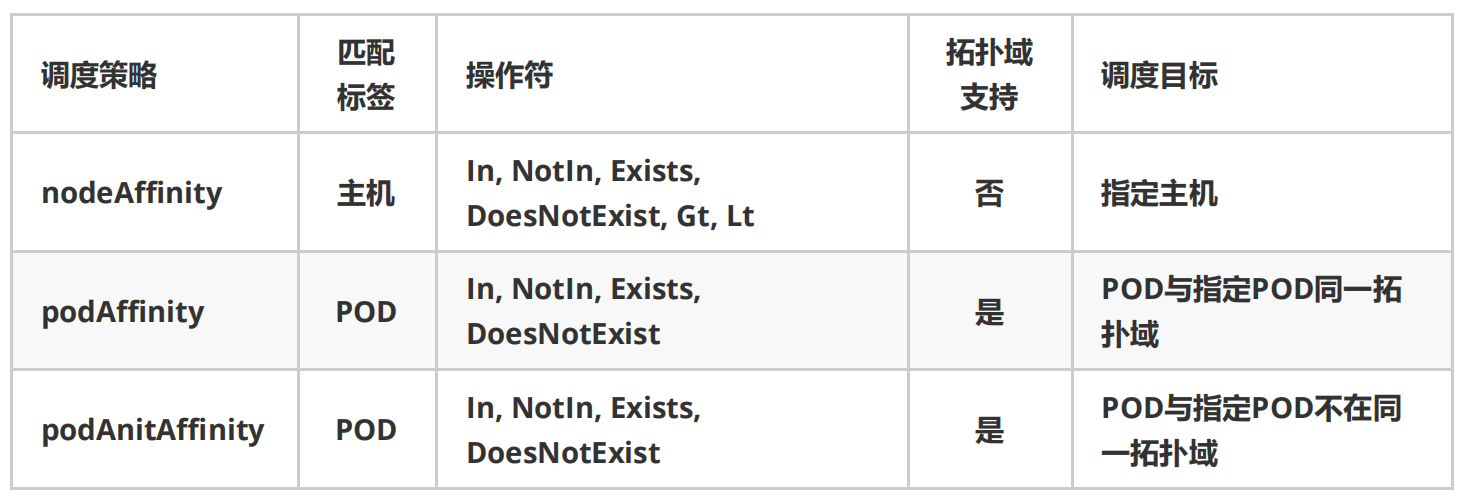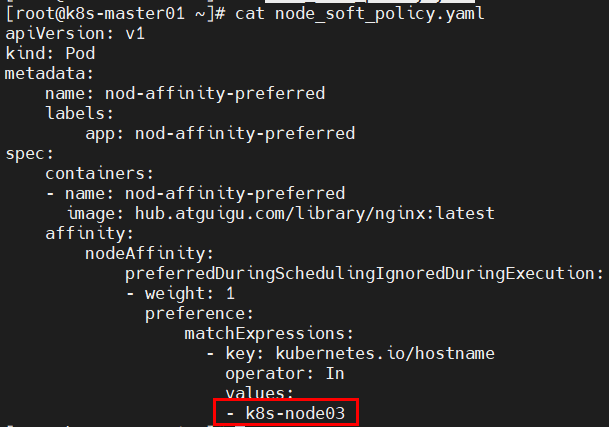kubernetes集群系列资料14--scheduler介绍
一、scheduler介绍
scheduler主要任务按照一定规则把定义的pod分配到集群的node上。scheduler作为单独的程序运行,启动之后会一直监听API server,获取podSpec.NodeName为空的pod,对每个pod都会创建一个binding,表明该pod应该放到哪个node上。调度会考虑到很多问题:
效率:调度的性能要好,能够尽快地对大批量的pod完成调度工作;
公平:如何保证每个节点都能被分配资源;
资源高效利用:集群所有资源最大化被使用;
灵活:允许用户根据自己的需求控制调度的逻辑。
调度过程:
1)过滤掉不满足条件的node,这个过程称为predicate;如果在predicate过程中没有合适的节点,pod会一直在pending状态,不断重试调度,直到有节点满足条件。经过这个步骤,如果有多个节点满足条件,就继续priority过程。
2)对通过的node按照优先级排序,该过程称为priority;
3)最后从中选择优先级最高的node。
该过程任何一步骤错误,就直接返回错误。
predicate有一系列的算法可以使用:
podFitsResources:节点上剩余的资源是否大于pod请求的资源;如果不满足,直接pass掉该node。
podFitsHost:如果pod指定了nodeName,检查节点名称是否和NodeName匹配;如果不满足,直接pass掉该node。
podFitsHostPorts:节点上已经使用的port是否和pod申请的port冲突;如果不满足,直接pass掉该node。
podSelectorMatches:过滤掉和pod指定的label节点是否匹配;如果不匹配,直接pass掉该node。
NoDiskConflict:已经mount的volume和pod指定的volume是否冲突;如果冲突,直接pass掉该node,除非它们都是只读。
priority:优先级由一系列键值对组成,键是该优先级项的名称,值是它的权重(该项的重要性)。这些优先级选型包括:
LeastRequestedPriority:通过计算CPU和memory的使用率来决定权重,使用率越低权重越高。换句话说,这个优先级指标倾向于资源使用比例更低的节点。
BalanceResourceAllocation: 节点上CPU和memory使用率越接近,权重越高;该键与上面的键一起使用,不应单独使用。
ImageLocalityPriority:倾向于已经有要使用镜像的节点,镜像总大小值越大,权重越高。
通过算法对所有的优先级项目和权重进行计算,得出最终结果。
自定义调度器:
除了K8S自带的调度器default-scheduler,你可以编写自己的调度器。通过spec:schedulername参数指定调度器的名字,可以为pod选择某个调度器进行调度。
node亲和性
pod.spec.affinity.nodeAffinity
preferredDuringSchedulingIgnoredDuringExecution:软策略,pod优先调度到该node;若不满足则可进行其他调度;pod有多个软策略时,则会优先选择权重较高的node;
requiredDuringSchedulingIgnoredDuringExecution:硬策略,pod必须调度到该node;若不满足则不调度,会报错;

kubectl get node --show-labels #查询node的label;
kubernetes.io/hostname为键名,k8s-node02为键值。
键值运算关系:
In:label的值在某个列表中;
NotIn:label的值步在某个列表中;
Gt:label的值大于某个值;
Lt:label的值小于某个值;
Exists:某个label存在;
DosesNotExist:某个label不存在;
pod亲和性
pod.spec.affinity.podAffinity/podAntiAffinity
preferredDuringSchedulingIgnoredDuringExecution:软策略,;
requiredDuringSchedulingIgnoredDuringExecution:硬策略;
亲和性/反亲和性调度策略比较如下:

污点taint
节点亲和性,是pod的一种属性(偏好或硬性要求),它使pod被吸引到一类特定的节点。taint则相反,它使得节点排斥一类特定的pod。
taint和toleration相互配合,可用来避免pod被分配到不合适的节点上。每个节点上都可以应用一个或多个taint,这表示对于那些不能容忍这些taint的pod,是不会被该节点接受的。如果将toleration应用于pod上,则表示这些pot可以(但不要求)被调度到具有匹配taint的节点上。
可使用kubectl taint命令给某个node设置污点,此后node和某类pod存在排斥关系,可让node拒绝某pod的调度执行,甚至可以将node中已存在的pod驱逐出去。
每个污点的组成如下:
key=value:effect
每个污点有一个key(自行定义)和value(自行定义)作为污点的标签,其中value可为空,effect描述污点的作用。当前effect支持如下3个选项:
NoSchedule:表示k8s将不会将pod调度到具有该污点的node上。
PreferNoSchedule:表示k8s将尽量避免将pod调度到具有该污点的node上。
NoExecute:表示将k8s将不会将pod调度到具有该污点的node上,同时会将node上已存在的pod驱逐去除。
案例1:node亲和性---硬策略
cat >node_hard_policy.yaml<<eof
apiVersion: v1
kind: Pod
metadata:
name: nod-affinity-required
labels:
app: nod-affinity-required
spec:
containers:
- name: nod-affinity-required
image: hub.atguigu.com/library/nginx:latest
affinity:
nodeAffinity:
requiredDuringSchedulingIgnoredDuringExecution:
nodeSelectorTerms:
- matchExpressions:
- key: kubernetes.io/hostname
operator: NotIn
values:
- k8s-node02
eof
kubectl apply -f node_hard_policy.yaml
kubectl get pod -o wide
kubectl delete -f node_hard_policy.yaml
kubectl get pod -o wide
kubectl apply -f node_hard_policy.yaml
kubectl get pod -o wide
kubectl delete -f node_hard_policy.yaml
kubectl apply -f node_hard_policy.yaml
kubectl get pod -o wide

结果显示:硬策略要求必须每次不能调度到node2节点。当修改为IN时,会立即调度到node2;当修改为调度到不存在的node时,则会任务会pending。




案例2:node亲和性---软策略
cat >node_soft_policy.yaml<<eof
apiVersion: v1
kind: Pod
metadata:
name: nod-affinity-preferred
labels:
app: nod-affinity-preferred
spec:
containers:
- name: nod-affinity-preferred
image: hub.atguigu.com/library/nginx:latest
affinity:
nodeAffinity:
preferredDuringSchedulingIgnoredDuringExecution:
- weight: 1
preference:
matchExpressions:
- key: kubernetes.io/hostname
operator: In
values:
- k8s-node02
eof
kubectl apply -f node_soft_policy.yaml kubectl get pod -o wide kubectl delete -f node_soft_policy.yaml kubectl apply -f node_soft_policy.yaml kubectl get pod -o wide kubectl delete -f node_soft_policy.yaml kubectl apply -f node_soft_policy.yaml kubectl get pod -o wide

结果显示:软策略要求优先调度到node2节点。当修改为调度到不存在的node时,则会随机调度。


案例3:pod亲和性
cat >pod-1.yaml<<eof
apiVersion: v1
kind: Pod
metadata:
name: node01
labels:
app: node01
spec:
containers:
- name: node01
image: hub.atguigu.com/library/nginx:latest
eof
kubectl apply -f pod-1.yaml
kubectl get pod -o wide --show-labels
cat >pod-2.yaml<<eof
apiVersion: v1
kind: Pod
metadata:
name: node02
labels:
app: node02
spec:
containers:
- name: node02
image: hub.atguigu.com/library/nginx:latest
eof
kubectl apply -f pod-2.yaml
kubectl get pod -o wide --show-labels
cat >pod-affinity.yaml<<eof
apiVersion: v1
kind: Pod
metadata:
name: pod-3
labels:
app: pod-3
spec:
containers:
- name: pod-3
image: hub.atguigu.com/library/nginx:latest
affinity:
podAffinity:
requiredDuringSchedulingIgnoredDuringExecution:
- labelSelector:
matchExpressions:
- key: app
operator: In
values:
- node01
topologyKey: kubernetes.io/hostname
podAntiAffinity:
preferredDuringSchedulingIgnoredDuringExecution:
- weight: 1
podAffinityTerm:
labelSelector:
matchExpressions:
- key: app
operator: In
values:
- node02
topologyKey: kubernetes.io/hostname
eof
kubectl apply -f pod-affinity.yaml
kubectl get pod -o wide
kubectl delete -f pod-affinity.yaml
kubectl apply -f pod-affinity.yaml
kubectl get pod -o wide
kubectl delete -f pod-affinity.yaml
kubectl apply -f pod-affinity.yaml
kubectl get pod -o wide
kubectl delete -f pod-affinity.yaml
kubectl apply -f pod-affinity.yaml
kubectl get pod -o wide

结果显示:所有pod都调度到亲和性高的pod;软硬策略与node亲和性类似。
案例4:污点
cat >pod-1.yaml<<eof
apiVersion: v1
kind: Pod
metadata:
name: node01
labels:
app: node01
spec:
containers:
- name: node01
image: hub.atguigu.com/library/nginx:latest
affinity:
nodeAffinity:
requiredDuringSchedulingIgnoredDuringExecution:
nodeSelectorTerms:
- matchExpressions:
- key: kubernetes.io/hostname
operator: In
values:
- k8s-node01
eof
kubectl apply -f pod-1.yaml
cat >pod-2.yaml<<eof
apiVersion: v1
kind: Pod
metadata:
name: node02
labels:
app: node02
spec:
containers:
- name: node02
image: hub.atguigu.com/library/nginx:latest
affinity:
nodeAffinity:
requiredDuringSchedulingIgnoredDuringExecution:
nodeSelectorTerms:
- matchExpressions:
- key: kubernetes.io/hostname
operator: In
values:
- k8s-node02
eof
kubectl apply -f pod-2.yaml
kubectl get pod -o wide --show-labels
kubectl describe node k8s-master01 |grep Taints #查看k8s-master01节点存在污点:NoSchedule;所以,该节点不会被调度任务。
kubectl taint nodes k8s-node01 kill=node01:NoExecute
kubectl get pod -o wide --show-labels
结果表明:设置污点后,可将pod从node驱逐。 
案例5:toleration
kubectl describe node k8s-node02 |grep Taints #查看taint设置,以便填写
cat >pod-1-1.yaml<<eof
apiVersion: v1
kind: Pod
metadata:
name: node01
labels:
app: node01
spec:
containers:
- name: node01
image: hub.atguigu.com/library/nginx:latest
tolerations:
- key: "kill"
operator: "Equal"
value: "node01"
effect: "NoExecute"
tolerationSeconds: 3600
eof
kubectl apply -f pod-1-1.yaml
kubectl get pod -o wide --show-labels
结果表明:设置了toleration的污点允许调度。

案例6:通过nodeName指定node调度
cat >assign_node_schedule.yaml<<eof
apiVersion: extensions/v1beta1
kind: Deployment
metadata:
name: nginx-deployment
spec:
replicas: 7
template:
metadata:
labels:
app: nginx
spec:
nodeName: k8s-node02
containers:
- name: nginx
image: hub.atguigu.com/library/nginx:latest
ports:
- containerPort: 80
eof
kubectl apply -f assign_node_schedule.yaml
kubectl get pod -o wide --show-labels



